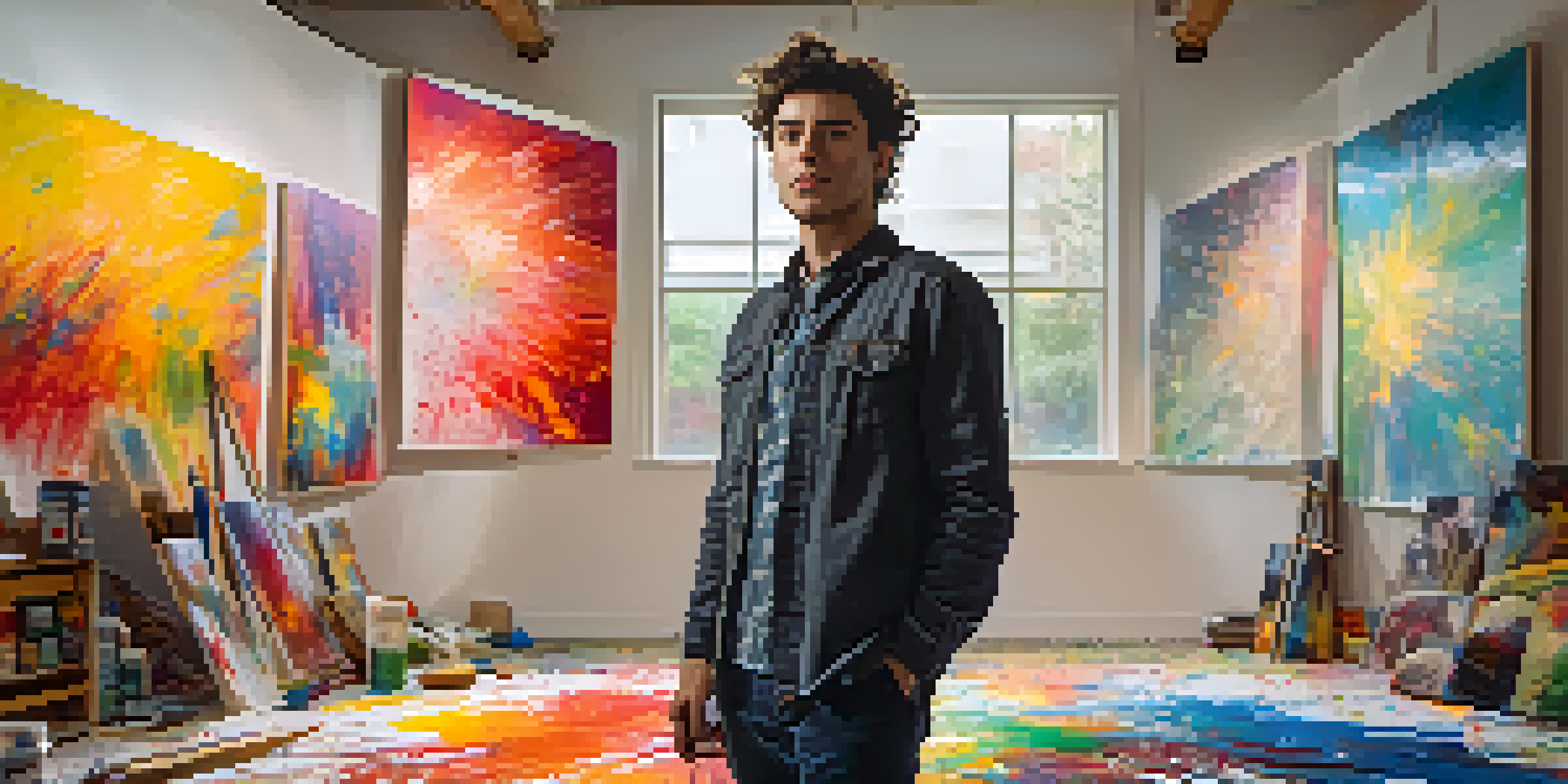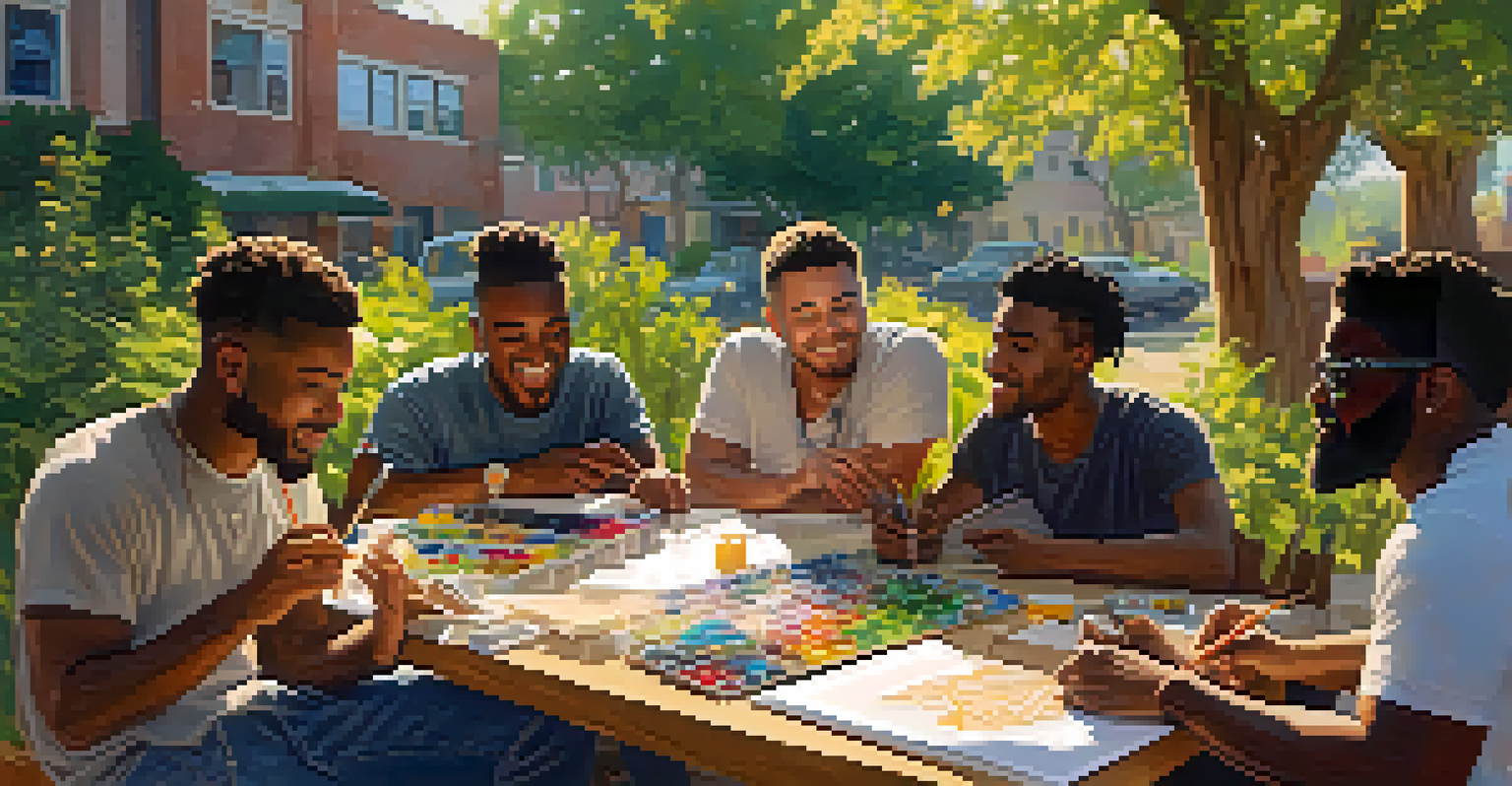Masculinity in Art: A Study of Male Artists' Representations

Understanding Masculinity: A Historical Perspective
Masculinity has been depicted in various ways throughout art history, often reflecting societal values and norms of the time. From the heroic figures of ancient Greece to the rugged individualism of the American West, these representations tell us much about what it means to be male in different contexts. Artists have used their work to challenge or reinforce these notions, creating a dialogue that continues today.
The greatest artists are not those who create the most beautiful works, but those who create the most honest ones.
In the Renaissance, for instance, there was a strong focus on physicality and strength in male subjects, often idealizing their forms. This was a reflection of the time's emphasis on humanism and the celebration of the male body as a symbol of power. However, as we move through history, we see fluctuations in these ideals, influenced by changing cultural and political landscapes.
Today, discussions around masculinity in art often involve questioning traditional representations. Artists are now more likely to explore vulnerability, emotional depth, and the complexities of male identity, moving beyond the established norms that have dominated for centuries.
Famous Male Artists and Their Perspectives on Masculinity
Many renowned male artists have left their mark on the depiction of masculinity, each bringing their unique perspective to the canvas. For instance, Pablo Picasso's work often reflected the turbulent emotions and complexities of male relationships, challenging the idea of stoic masculinity. His varied styles and forms can be seen as a visual representation of the chaotic nature of male identity.

Similarly, artist Frida Kahlo, though not male herself, captured the male experience through her relationships with men, providing a counter-narrative to traditional masculine ideals. Her introspective approach often revealed the vulnerabilities beneath the surface of her male subjects, encouraging viewers to rethink their understanding of masculinity.
Masculinity's Evolving Representation
Art has historically depicted masculinity in various ways, reflecting societal values and norms, but contemporary artists are now challenging traditional ideals.
These artists, among many others, highlight how personal experiences and societal expectations shape the portrayal of masculinity in art. Their works invite audiences to engage with more nuanced and diverse interpretations of what it means to be male.
Masculinity in Contemporary Art: A Shift in Narrative
In contemporary art, the representation of masculinity has evolved dramatically, reflecting broader societal changes. Artists are increasingly questioning the traditional expectations of male roles, embracing concepts such as emotional expression and vulnerability. This shift allows for a more inclusive understanding of masculinity that resonates with a diverse audience.
Art is a reflection of society, and through it, we can explore the complexities of identity and gender.
For instance, the work of contemporary artists like Kehinde Wiley challenges stereotypes by depicting men of color in powerful, regal poses, traditionally reserved for white men in classical art. This not only redefines masculinity but also highlights the intersectionality of race and gender, making a significant statement about identity.
Moreover, installations and performances that address mental health and societal pressures further emphasize the need for a more compassionate understanding of masculinity. These contemporary narratives encourage dialogue and reflection, paving the way for a more holistic approach to male identity in art.
The Influence of Culture on Male Artistic Expression
Cultural background plays a crucial role in shaping how masculinity is represented in art. Different cultures have distinct norms and expectations for male behavior, which can significantly influence artistic expression. For example, in some Indigenous cultures, masculinity may be tied to community and collaboration rather than individualism, offering a refreshing perspective on male identity.
Additionally, global movements such as feminism and LGBTQ+ advocacy have prompted male artists to reconsider their roles within these frameworks. They are now more likely to engage with themes of gender fluidity and challenge binary notions of masculinity, creating art that reflects a more inclusive understanding of gender.
Vulnerability Redefined in Art
Many modern artists are embracing vulnerability as a strength, inviting viewers to reconsider emotional depth and intimacy within the context of masculinity.
This cultural lens provides a rich tapestry of experiences and interpretations of masculinity, allowing for a broader discussion in the art world. As artists draw from their unique backgrounds, they contribute to a diverse conversation that enriches our understanding of masculinity in contemporary society.
Masculinity and Vulnerability: A New Artistic Frontier
Traditionally, vulnerability has been viewed as a weakness in the context of masculinity, but many contemporary artists are challenging this notion. By exploring themes of vulnerability in their work, these artists invite viewers to reconsider what it means to be strong or masculine. This can be seen in works that depict emotional struggle, intimacy, and mental health issues, reflecting a more nuanced perspective.
For example, artists like Tracey Emin and her confessional style embrace vulnerability, showcasing personal experiences that resonate with broader themes of male emotionality. Their work encourages men to embrace their feelings and share their stories, contributing to a culture where vulnerability is seen as a strength rather than a flaw.
This artistic exploration of vulnerability not only enriches the narrative of masculinity but also fosters empathy and connection among viewers. By breaking down barriers, these artists create a space for open dialogue about male emotions and experiences.
The Role of Gender Identity in Artistic Masculinity
Gender identity is another critical factor in how masculinity is represented in art. Many male artists today are exploring their own identities, often challenging traditional notions of masculinity in the process. This exploration can lead to powerful works that reflect a more fluid understanding of gender, blurring the lines between masculine and feminine.
Artists like David Hockney and his use of color and form often explore themes of gay identity and masculinity, pushing against the boundaries of conventional representations. Their work invites viewers to consider how identity shapes our understanding of gender roles and expectations.
Cultural Influence on Masculinity
Cultural backgrounds significantly shape artistic expressions of masculinity, leading to diverse interpretations that challenge conventional gender norms.
As art continues to evolve, the conversation around gender identity in relation to masculinity becomes increasingly important. It encourages not only artists but also audiences to reflect on their perceptions of masculinity and the complexities that come with it.
Conclusion: The Future of Masculinity in Art
As we look to the future, the representation of masculinity in art is poised for continued transformation. With ongoing conversations about gender, culture, and identity, artists are likely to explore even more diverse and complex portrayals of masculinity. This evolution reflects broader societal changes, encouraging a more inclusive understanding of male identity.
The importance of these discussions cannot be overstated, as they challenge long-standing narratives and promote empathy and understanding. By engaging with new perspectives, artists and audiences alike can contribute to a richer dialogue about masculinity that transcends traditional boundaries.

Ultimately, the future of masculinity in art holds the promise of deeper exploration and understanding, paving the way for a more compassionate and holistic view of what it means to be male in today's world.